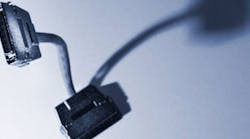Jim Montague is the Executive Editor of Control. Jim has spent the last 13 years as an editor and brings a wealth of automation and controls knowledge to the position.
The always data-heavy world of control and automation is getting more intense — cloud computing alone is going to need an awfully big drainpipe. So there will be lots of fiberoptic lines, high-gain antennas, Ethernet and other copper cabling, but all these networks will still begin and end with connectors. Talk about a big job.
"The primary push in connectors is for higher density, such as M8 and M12 connectors, which have more pins and can handle more signals," says Aaron Henry, North American marketing manager for Murrelektronik. "We also see expanded use of Gigabit Ethernet connectors, such as special RJ45 components, which provide more data density. A regular RJ45 has four pins and runs at the usual 10/100 Mbps or 100BaseT, but a Gigabit RJ45 has eight pins and runs at 10/100/1000 Mbps or 1000BaseT, which is up to 1 Gbps. Ours is called the RJ45 Pro."
Mike Miclot, marketing vice president for Belden Americas, confirms that. "Device manufacturers are finding that traditional RJ45 connectors are susceptible to intrusion from water or corrosives, and so they need a better seal. That's why we introduced shrouded RJ45s for better protection, and four- and eight-pin versions to handle Gigabit and coming 40 Gb speeds. Our Lumberg division has M8 and M12 connectors that are lockable, IP67-rated, and offer even more protection."
Not only are connectors getting faster and better able to handle huge volumes of data, but they're also getting smarter, with several types of basic data processing that's on board or very close to the connector. This is helpful because useful intelligence added by a microprocessor in or near its application means it can secure data, analyze it and initiate needed changes faster and with less interference.
Rich Carlson, senior product manager for Han industrial connectors at Harting North America, reports that most smart connectors consist of microprocessors or printed circuit boards (PCBs) inside modules with connection or termination points. For instance, Han's modular connectors have collected and processed data for many years, but counterparts like Han-Elisa connectors have consolidated into smaller, Lego-like form factors even as they gained intelligence. "Now we have 34x53x15 mm connectors, and we can condense six or seven of these modules onto a cable or mount it on a frame to save real estate," Carlson says.
Some connectors are adapted for harsher settings, and even have more connections. For example, Han-Yellock connectors are IP67-rated and can handle up to 20 A, but they also have a potential multiplier to other component parts. "Basically, where most connectors are point-to-point, Yellock has one wire going into the connector and four or five coming out," Carlson explains. "Adding an adapter allows us to take terminal block functions into our connectors, which can save a lot of wire and labor costs."
The two worlds of power for connectivity and communications are merging, and they'll soon add power for motors to the club, says Rick Griffin, global business development manager for controls at Molex. "We've already developed and launched a Circular Hybrid Technology (CHT) in M12 connectors with 10-A, 24-V power and shielded 10/100 BASE-T Ethernet, and this saves wire and labor by running 24-V and communications through one connection," explains Griffin. "Soon, we'll take a 'spinal cord' approach to connectivity by adding three-phase motor power up to 600-V with high bandwidth, noise-immune fiber optics using Molex Fiber expertise."
Jason Moore, product line manager for automation and control at Eaton, concurs. "The whole framework of connectivity is growing and evolving," he says. "Traditional wire, solder and ferrules are giving way to clip-on connectors to smart I/O systems and devices."
In fact, Eaton recently refined its SmartWire-DT connection and cable system to simplify panel building and modular machine construction. Its connectors are simple to adjust, crimp and tie into SmartWire-DT's single, flat, green, eight-pole cable. A microprocessor and ASIC in its pilot module enable other devices to run on SmartWire-DT's network. "Traditional PLC systems consist of a controller and I/O cards that plug into the back of the PLC," Moore says. "However, SmartWire-DT doesn't need an I/O card because its cable connects directly to the controller, its chip recognizes components as I/O points, and so they're already I/O-capable."





